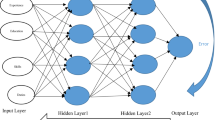Abstract
For many years interviews and written applications required the job applicant to provide answers to a wide range of questions. Initially the employer could and did ask questions on any subject in which he/she had an interest, including those of a personal nature. If the prospective employee refused to provide the information, the application was simply discarded without regard for any issues arising, involving discriminatory/disparate treatment or disparate impact on the job applicant. This article examines national and regional retail outlet employment applications. Our examination of these employment applications considers the information each application solicits, whether those questions seek information that would likely reveal an applicant's membership in a protected class, and thus to what degree retail employment applications create a discriminatory legal liability for the employer.
Similar content being viewed by others
REFERENCES
Americans with Disabilities Act, 42 U.S.C. § 12101 et seq. (1990).
Befort, S. F. (1997, Spring). Pre-employment screening and investigation: Navigating between a rock and a hard place. Hofstra Labor Law Journal, 14 Hofstra Lab. L.J. 365.
Bland, T. S., & Stalcup, S. S. (1999). Accurate applications: Legal implications of employment applications. Security Management, 43(6), 38-40.
Dise, J. H. (1994). Avoiding liability in employee selection: Risk of discrimination lawsuits. School and College, 33(6), 32-34.
EEOC. (1995). Enforcement guidance on pre-employment inquiries under the Americans with Disabilities Act. 8 Fair Empl. Prac. Man. (BNA) 405:7191.
Frierson, J. G., Bayes, P. E., Jolly, J. P., & McKee, T. E. (1988). The legality of pre-employment questions in Ohio. The Ohio CPA Journal, 47(4), 5-11.
Glaser, B. G., & Strauss, A. L. (1967). The Discovery of Grounded Theory. Chicago: Aldine.
Griggs v. Duke Power Company, 401 U.S. 424 (1971).
Hoffman, S. (2001). Preplacement examinations and job-relatedness: How to enhance privacy and diminish discrimination in the workplace. Kansas Law Review, 49 Kan. L. Rev. 517.
May, T. (1995). Social Research: Issues, Methods and Process. Buckingham: Open University Press.
Mostyn, B. (1985). The content analysis of qualitative research data. In Brenner, M., Brown, J., & Canter, D. (Eds.), The Research Interview: Uses and Approaches, 115-145. London: Academic Press.
The Age Discrimination in Employment Act, 29 U.S.C. § 621 et seq. (1967).
Title VII of the Civil Rights Act as amended, 42 U.S.C. § 2000e et seq. (1964).
Webb, J. W., Campbell, D. T., Schwartz, R. D., Sechrest, L., & Grove, J. (1981). Nonreactive Measures in the Social Sciences, 2nd ed. Boston: Houghton Mifflin.
Author information
Authors and Affiliations
Corresponding author
Rights and permissions
About this article
Cite this article
Fine, C.R., Schupp, R.W. Liability Exposure Trends in Recruitment: An Assessment and Analysis of Retail Employment Applications. Employee Responsibilities and Rights Journal 14, 135–143 (2002). https://doi.org/10.1023/A:1021137321006
Issue Date:
DOI: https://doi.org/10.1023/A:1021137321006




